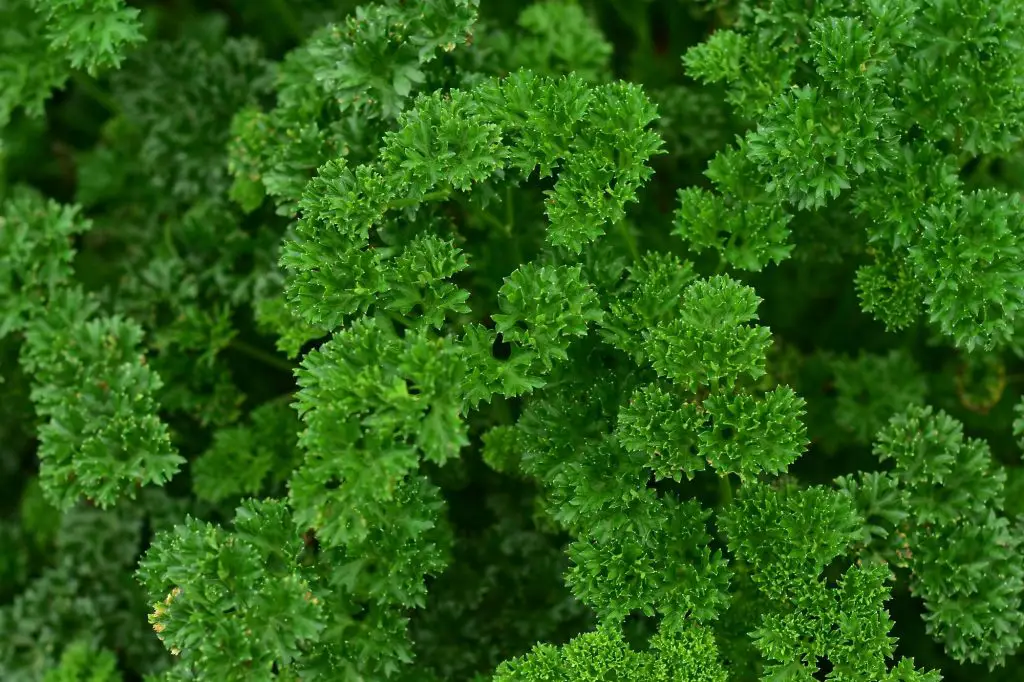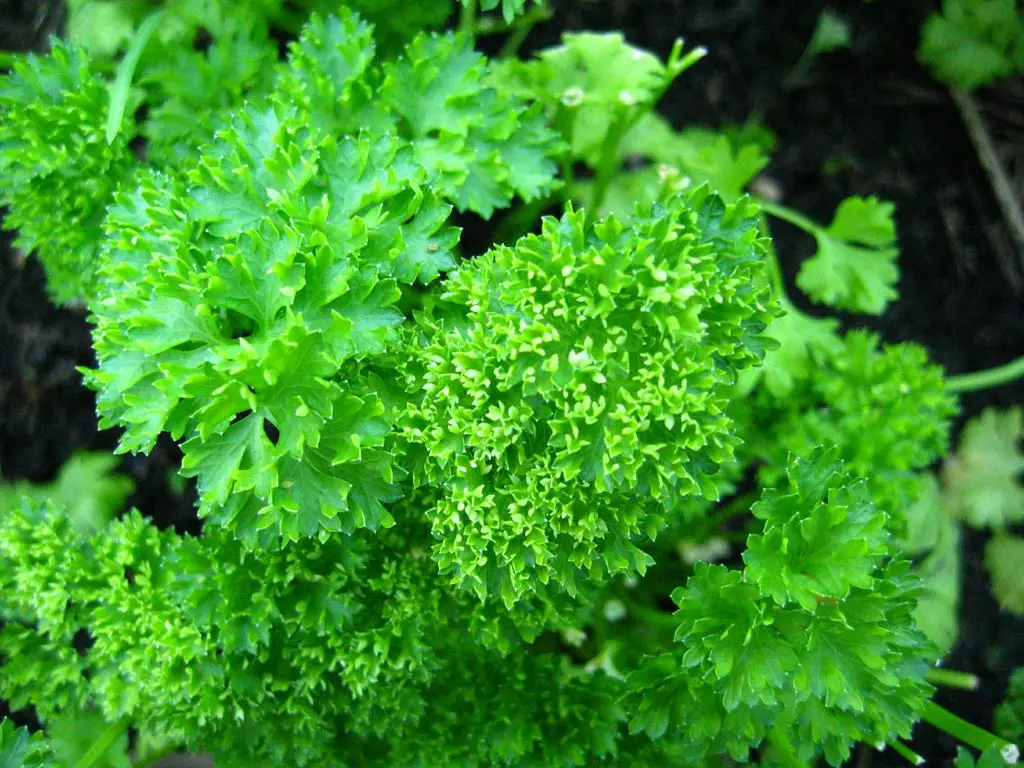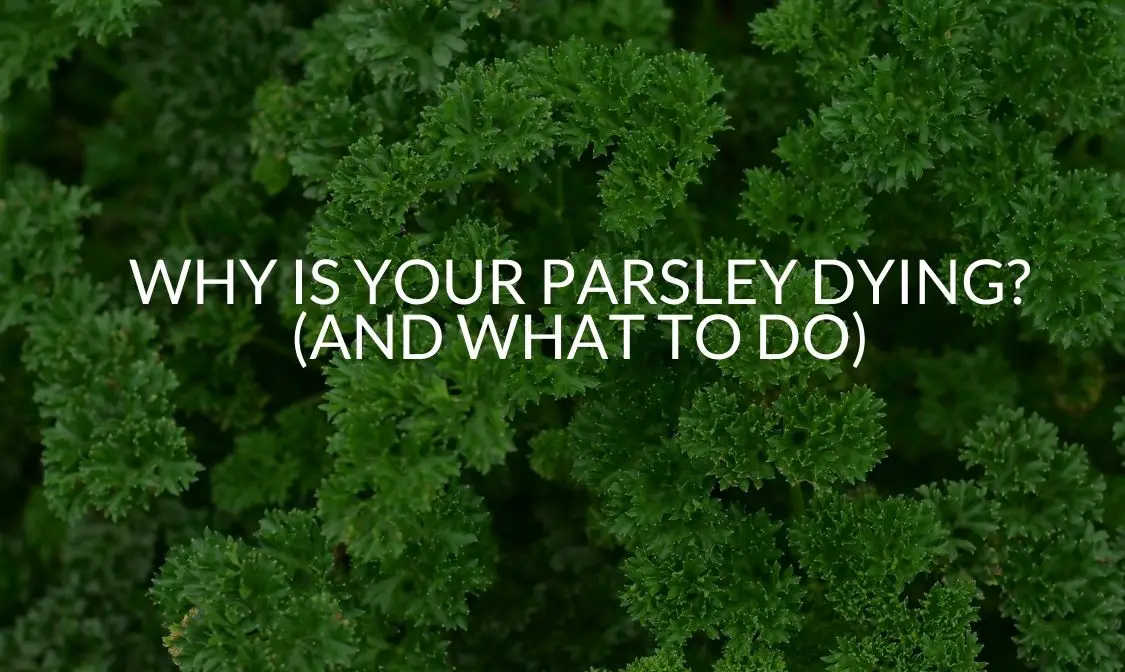There are a number of reasons which could cause a hardy herb like parsley to die, including over and underwatering, too much or too little sunlight, storage environment, pesky insects or dreaded rot/fungus.
Parsley is renowned for being easy to grow, rarely problematic and typically quite a tough cookie in the herb world! But on occasion, different variables in their rearing, surroundings and care can lead to premature death in the plant.
But don’t let dying plants dampen the keen emerging gardener in you; check out the typical causes of parsley deterioration below and how you can stop them in their tracks, allowing fresh, healthy plants a chance to thrive, and making your meals even tastier!
What Are The Signs That Your Parsley Is Dying?
The tell-tale signs that your parsley plant is struggling are wilting, yellowing (or general discolouration) in leaves, and drooping stems. What’s the age-old rule hairdressers love to preach? Cutting hair promotes growth! The same can be applied to your parsley plant.
Regular trimming and maintenance improve the yield. The more overgrown the plant is, the more the stems are vying for sunlight. Smaller shoots can struggle to thrive if they are canopied by larger, tangled leaves and snaking stems above them.
Using the same haircut analogy, snipping off any yellow, spotted and/or wilted leaves is as effective as cutting off dead ends. They serve no purpose to your plant other than to stunt their growth – your plant might look a little less bushy, but ultimately will be healthier and produce tastier leaves for your meals. Yellowing leaves can be caused by a variety of issues, including:
- Lack of Water (dehydration)
- Overwatering (saturation)
- Excessive Sun Exposure
- Sun/Light Deprivation
- Root/Crown Rot
- Environment/Site Conditions
- Predators such as spider-mites, butterflies and carrot flies
Reasons Why Your Parsley is Dying (and How You Can Stop It)
Lack Of Water
Plants have their core necessities to survive, and one of the obvious essentials is water. But just like Goldilocks, too little or too much are both harmful to your parsley plant and it is key to find the right balance.
A lack of water can result in your parsley becoming parched, droopy and stressed. Stems could appear brittle or fragile. Leaves could yellow or lighten considerably in colour. The growth of the herb could be stunted and the soil itself could pull away from the edges of the pot, similar to a drying out paint pot.
A lot of those who are new to plant-growing make the mistake of watering on a consistent schedule which, in theory, works great for humans and animals – but for plants, it is much better for their wellbeing to water them only when they need it.
Pick up your pot and feel its weight before delving in with the watering can. If the pot feels light, then yes, it most definitely could be time to water it.
Overwatering
Surprisingly, overwatering your parsley plant is more likely to kill it than underwatering it. You may feel that you are being very attentive towards your plant – yet too much moisture can saturate the soil, leading to unoxygenated roots and stimulating root rot (more on this below).
Additionally, insufficient drainage can spell the end for your plant – the environment in which your plant lives is just as important as tending to the plant itself. If water can’t drain through the bottom of your pot or container (usually aesthetically pleasing yet impractical ceramic pots are missing the key drainage holes underneath their bases) it sits and stagnates in your soil, often creating a rather stinky odour!
Check your pots before you buy them to see if they aren’t just designed to make your kitchen window look pretty – after all, a pretty pot can’t make up for a dead, wilted plant inside it!
There is always the option to carefully drill holes into the base of your pots to ensure air can get to the roots of your parsley and excess water can drain through. Place a dish underneath your pot to catch this water – it also gives your soil the opportunity to drink it back up once it is needed!
Test your parsley plant by feeling a couple of centimetres below the soil line to see where moisture could be hiding – if the top is dry but the rest of the soil underneath is damp, only a few millilitres of water are needed to wet the top and keep the dry, cracked dirt at bay.

Excessive Sun Exposure
Too much sun could spell disaster for your plant – especially in the heat of summer when the powerful rays can blanch and wilt your leaves and stems. This is because your parsley is evaporating more water than it can absorb – so place the parsley in adequate shade at the hottest parts of the day.
If the stems have gone a little flaccid, this could simply be a defence mechanism to conserve water. They should perk up again when the temperature drops of an evening or if they are moved out of direct sunlight.
Sun Deprivation
The most common sign that your plant is not getting enough sunlight is stunted leaf growth, elongated stems and discolouration. If you keep your parsley plant indoors, ensure it is near a window that gets a good dose of sunlight throughout the day and isn’t blocked by trees or walls.
If your stems are growing wild and wispy, they are searching for sunlight; ensuring that they get at least a few hours each day will keep them a healthy green colour and growing up, rather than out, like vines!
As well as not getting enough direct sunlight, they may be suffering due to the same issue as supermarket parsley plants – artificial lights in your home do not offer your parsley the same intensity and wavelengths that sunlight can, so they may not thrive as well.
But in colder months and darker days, artificial light is better than none at all – so opt for bulbs instead of frostbite, which really will send your parsley to its doom!
Root/Crown Rot
Root rot’s origins are pretty self-explanatory – it is a soil-borne disease that attacks the healthy roots and turns them black, soft and pulpy. Crown rot, however, manifests at the surface of the soil, close to the stems, rather than below it. You can find out more about root rot here.
It is caused by two issues; the first being overwatering – soil is bogged down with excess moisture and the roots are starved of oxygen and effectively drown. Just like animal decomposition, the roots begin to erode and break down, affecting other surviving roots around them.
Root rot ultimately results in the collapse and death of the plant. Reversing the effects is difficult – even if soil moisture levels return to normal, more often than not the damage has already been done.
On the other hand, a root rot fungus may be lying dormant in the soil, and one single occurrence of overwatering serves as a catalyst for it to grow and spread. The key to tackling root and crown rot is acting fast to salvage what is left of the healthy plant. You could still be in time!
Removing the plant carefully in its entirety from the boggy soil – roots and all – can allow you to inspect the plant and judge whether the root rot is significant or only at the preliminary stages of growth.
If it is the latter, gently rinse the roots under a running tap to rid them of all infected soil, and trim the decaying roots with clean scissors. Healthy roots should be white and firm, and easy to differentiate from the infected ones. A further step to guarantee the rot is destroyed is to spray the unaffected roots with a fungicide.
It stands to reason that yellowing or spotted leaves were the first indication of root rot, to begin with, so cutting off the offending fronds and their discoloured stems will help your poorly parsley recover – fewer leaves and stems allow roots to regrow at a faster pace.
Finally, dispose of the infected soil and wash out any pots thoroughly to kill all remnants of the rot. Better yet, use fresh pots with adequate drainage at the bottom. Your parsley has moved house for an upgrade, and a better environment will help it to flourish.
Environment
A happy home life is vital to all of us – and the same goes for your parsley plant. Poor living conditions including lack of space, inappropriate pots (as discussed above) and moving from indoor to outdoor spaces (or vice versa) can all lead to stress within the plant and ultimately leading it down an untimely route to death.
If you have opted to purchase a supermarket parsley plant, these herbs are overcrowded, packed tight into small pots and have lived the best parts of their lives surviving off artificial light and meagre water access. As soon as you are able, remove these plants from their plastic packaging then separate and split them out into bigger pots (roots and all!).
These plants are designed to retain their appearance and flavour only until they are purchased, and will most likely die within a two-week window after coming home in your shopping bag. Fill your roomier pots with additional nutrient-enriched compost or soil, so your plants have plenty of space to grow. Give them good water, and a dose of good old-fashioned sunlight – they’ll soon thrive!
Be careful not to overdo it, though – keep your supermarket plant inside for the first few weeks before moving it before gradually introducing it to an outdoor climate, if that is your preferred method of growing your plants.
It is important that your plant is given the opportunity to climatise when it has been cultivated inside – just like jumping in an ice bath, a shock from a change in temperature and climate can cause significant stress to your little parsley plant!
Pesky Predators
Your parsley can fall victim to a number of minute, malevolent creatures such as carrot flies, spider mites and swallowtail butterflies. Female carrot flies lay their eggs in the soil, which hatch into tiny, white worms, hungry for the roots of your parsley. They cause rot and decomposition from under the surface.
Spider-mites like warm, dry conditions, so will chomp on your parsley leaves and will avoid the moist soil underneath. An indication that they are around might be giveaway ultra-fine webs, almost with the appearance of dust, clinging to the underside of the leaves. They devour the leaf tissue, causing pale or reddish discoloured spots to appear, called stipples, followed by larger yellow discolouration.
Finally, swallowtail butterflies will lay their eggs on your plant, and their greedy caterpillars can do some serious damage by dining on the leaves for up to two weeks until they go through metamorphosis.
The best defence against these pests is keeping your parsley plant as healthy as can be. It will have the best chance at resisting these critters if there aren’t any other existing issues it is fighting against. Regular trimming of yellowing, damaged leaves can protect healthier ones by removing clingy bugs before they can feast on fresh quality foliage.
Using taller pots for your parsley makes it more difficult for female carrot flies to lay their eggs, as they typically only fly close to the ground. Spraying leaves with water, and not just dousing roots and crown, makes your plant an unfavourable place to live for spider mites, and gently wiping dusty leaves once a week with a damp cloth will keep bugs at bay.

Conclusion
Learning the art of herb gardening is all about trial and improvement – a number of variables can stand in your way of producing a fantastically flavoursome and healthy parsley plant.
But fear not; once you have mastered the basics of growing parsley, and most importantly, can spot the first signs of illness in your plant, it is easy to tackle the issues head-on before they can kill off your shoots entirely. Now armed with a crash course in botany, you’re all set to become a number one parsley paramedic!

